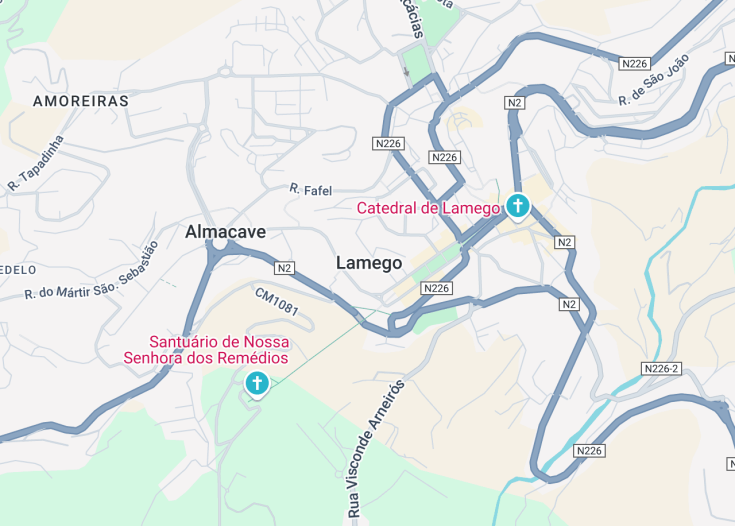Located in the north of Portugal, nestled among the terraced slopes of the Douro River Valley, Lamego is a captivating blend of historical heritage and natural beauty. This ancient town is known for its baroque architecture, like the Sanctuary of Our Lady of Remedies, featuring an iconic 686-step baroque staircase.
Lamego’s rich history extends to the twelfth century, offering visitors an array of historical sites, museums, and traditional Portuguese vineyards that produce the renowned Douro wines. A visit here promises a stimulating journey through time coupled with idyllic vineyard landscapes.
For an unforgettable experience, consider visiting during the annual ‘Festa de Nossa Senhora dos Remédios’ in September, where traditional celebrations and processions illuminate the city.
Don’t miss trying the local culinary specialty, ‘bola de Lamego,’ a delicious bread filled with meats, during your visit — it perfectly complements the region’s wines.
Top things to do & see in Lamego
Select the following sights and activities to discover best tickets and tours available in Lamego.
Lamego: A Gateway to Tradition and Tranquility
| Country | Portugal |
| Time in Lamego | GMT+1 |
| Language spoken | Portuguese |
| Population | 26,691 (source: PORDATA) |
| Currency | Euro (EUR €) |
| Airports |
|
Lamego, nestled in Portugal’s northern Douro wine region, is a captivating blend of history, culture, and natural beauty. This small yet historical city offers a serene retreat into a landscape punctuated by vineyards, baroque architecture, and a storied past that invites exploration. Lamego is rich with heritage sites such as the Sanctuary of Our Lady of Remedies, an iconic shrine that sits atop an imposing staircase of nearly 700 steps, lined by ornate baroque motifs.
Where is Lamego?
Lamego is set in the heart of the Douro region, amidst rolling vineyards and verdant hills.
Distances:
| Route | Distance by car | Time by car |
|---|---|---|
| Porto to Lamego | 78 miles (125 km) | Approx. 1 hour 30 minutes |
| Vila Real to Lamego | 28 miles (45 km) | Approx. 45 minutes |
What is Lamego famous for?
Known for its elaborate religious festivals, particularly the ‘Festa de Nossa Senhora dos Remédios’, Lamego attracts visitors with its majestic cathedral, sweeping landscapes, and intricate azulejos (painted ceramic tiles).
History
Prehistoric Period & Early Settlement
The history of Lamego, nestled in Portugal’s northern regions, traces back to ancient times. Archaeological finds in the area reveal prehistoric human activity, indicating a long-standing presence in the region. With the advent of the Romans during the 1st century B.C., Lamego, then part of the broader Iberian Peninsula, saw significant developments including the establishment of routes connecting it to other parts of the empire.
711-1143: Moorish and Reconquista Influence
Following the Moors’ arrival in the 8th century, Lamego came under Islamic rule, a period during which its strategic importance grew. However, by the 11th century, during the Christian Reconquista, the town was repeatedly contested and eventually reclaimed by Christian forces. The importance of Lamego was heralded in medieval times, becoming a key religious and administrative center.
1143-1700: Medieval Flourish and Royal Connections
The medieval period marked a golden era for Lamego. It was during this time that, according to legend, the first king of Portugal, Afonso Henriques, was declared within the town’s bounds at the historic Council of Lamego in 1143. The following centuries saw a flourish of monastic life and the construction of many of its now famous landmarks, including the Lamego Cathedral and several Baroque-style chapels.
1700-present: Modern Developments
Moving into the modern era, Lamego has balanced its rich historical heritage with the needs of contemporary development. The town became an integral part of the Douro wine region, famous for its production of port wine. Throughout the 20th and 21st centuries, Lamego has developed its infrastructure while preserving its cultural heritage, making it a unique blend of old and new.
Visit Lamego
What to see and do in Lamego
Experience the rich tapestry of culture and history in Lamego. Visitors should not miss the Lamego Museum, housed in the old Episcopal Palace, which offers a fascinating glimpse into the region’s past through its extensive art collections. The twelfth-century Lamego Cathedral is another must-see, showcasing spectacular Romanesque architecture.
For those interested in the ecclesiastical history, the Sanctuary of Our Lady of Remedies features an iconic baroque staircase leading to the church, which offers panoramic views of the city. Lamego is also ideal for leisurely walks in its charming streets lined with traditional Portuguese buildings.
- Lamego Museum
- Lamego Cathedral
- Sanctuary of Our Lady of Remedies
Key Events in Lamego
Lamego is vibrant with cultural festivities throughout the year. Notably, the ‘Festa de Nossa Senhora dos Remédios’, held in late August to September, is an event filled with processions, music, and traditional dancing, attracting visitors from far and wide.
Best time to visit Lamego
Lamego is delightful throughout the year, but the ideal time to visit is between late spring and early fall, from May to October. During these months, the weather is pleasant, and the town’s major events, including the traditional ‘Festa de Nossa Senhora dos Remédios’, provide unique cultural experiences.
Is Lamego worth visiting?
Lamego is unquestionably worth a visit. With its rich blend of history, culture, and natural beauty, coupled with its significance in the religious and wine-making traditions of Portugal, the city offers a compelling experience.
Whether you’re exploring its ancient ruins, enjoying its local cuisine, or partaking in its vibrant festivals, Lamego promises a memorable journey through the heart of Portugal’s historical landscape.









